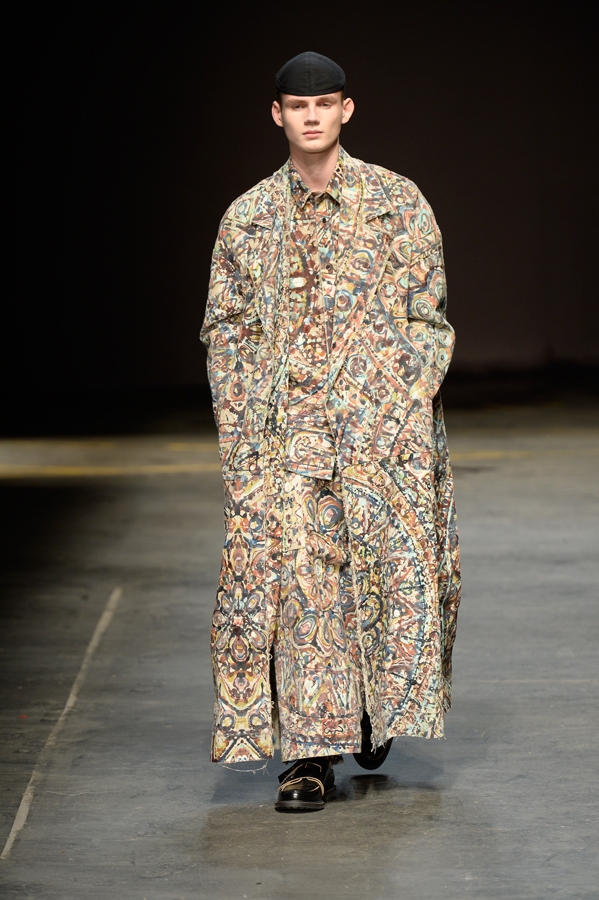In mid-June, London will host the fifth edition of LC:M – the menswear version of fashion week – promoted with much fanfare in the domestic media by buff ‘style ambassadors’ plucked largely from the world of light entertainment. The inevitable disjunction between expectation and delivery has seen mainstream reportage of the four editions to date settle into a cycle in which the advance excitement translates into confusion – and even derision.
This cycle is exacerbated by the almost total absence of meaningful discourse (outside of academic circles) in Britain relating to contemporary men’s fashion, and in particular the more conceptual tendency that one could call ‘advanced fashion’. In part this is due to a pervasive failure to distinguish between ‘fashion’ and the fashion industry. Just as the mainstream media feels most comfortable discussing art in terms of its auction price, so it feels easiest discussing fashion in terms of consumer trends and turnover, rather than ideas or technique.
The paucity of critical discourse is particularly vexed in relation to men’s fashion and, in the UK and US, a culturally difficult relationship with decoratively accoutred men. Writing in 1930, British psychoanalyst John Carl Flügel posited a theory of ‘the great male renunciation’, suggesting that the Industrial Revolution stimulated a renunciation of beautiful dress in favour of sober functionality – the adoption of the proto ‘white collar’ uniform of the business suit that was promoted during the nineteenth century as the global ideal of masculine dress (and which, by no coincidence at all, created an international market for then-abundant British-woven woollen cloth).
Little wonder that blending into the background seems so attractive when the alternative is a widespread mockery and even vilification of any group that steps out of line
The hangover from this is still evident in the depiction of nonwork dress as a site of middle-class male anxiety. A recent issue of The Guardian’s Saturday magazine dedicated to menswear carried an instructive essay guiding readers through the ‘minefield’ of casual dress, endorsing a wardrobe dominated by navy blue as, in effect, the safest way to remain invisible in plain sight. Little wonder that blending into the background seems so attractive when the alternative is a widespread mockery and even vilification of any group that steps out of line, be they ‘Dalston hipsters’ (now virtually a journalistic euphemism for ‘wanker’) or ‘Chavs’.
In a cultural and political landscape still dominated by white, privately educated men, London, despite its proud heritage of notable style subcultures, remains an uncomfortable site for fashion that doesn’t toe the bourgeois line. Most newspapers seem to find it hard to make space for new fashion that is culturally queer, black, gender-anxious, angry, bohemian, nocturnal or in some way disaffected. At worst it tampers unnervingly with long-established rules of masculine dress; at best, they simply don’t know how to talk about it.
Young designer Craig Green’s work runs heavily counter to the comforting bourgeois image promoted by LC:M’s ‘style ambassadors’: his last collection was dominated by full-length robes rendered in cotton canvas, hand-printed with colourful abstract designs reminiscent both of Persian carpets and the rose windows of a Gothic cathedral. These were silhouettes relating to multiple kinds of Britishness, ones – with ties still evident to the Middle East, Africa or some ilk of religious orthodoxy – that didn’t participate in the renunciation of the decorative. His work has, typically, fallen foul of mainstream commentators (lacking any way in which to intelligently discuss his work, one of LC:M’s ‘style ambassadors’ distanced himself from Green’s designs on a television show); while fashion-world gossip widely pronounces him one of the most exciting talents on the scene, it currently seems to lack a means to explain why this should be, beyond the habitual fluffy superlatives. Britain may have a heritage of masculine dress to be proud of, but if LC:M wants to promote the UK as a meaningful force in men’s fashion once more, it needs to work out how to discuss and openly embrace Craig Green and those other independent designers treading the thoughtful nonconformist path of advanced fashion.
This article was first published in the Summer 2014 issue
